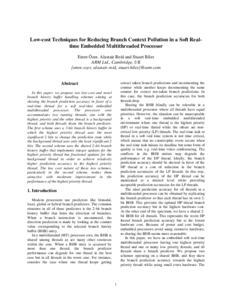Low-cost Techniques for Reducing Branch Context Pollution in a Soft Realtime Embedded Multithreaded Processor
Emre Özer, Alastair Reid, Stuart Biles
ARM Ltd
[pdf]
[doi]
19th Symposium on Computer Architecture and High Performance Computing (SBAC-PAD 2007)
Gramado, RS, Brazil
October 2007
Abstract
In this paper, we propose two low-cost and novel branch history
buffer handling schemes aiming at skewing the branch prediction
accuracy in favor of a real-time thread for a soft real-time
embedded multithreaded processor. The processor core accommodates
two running threads, one with the highest priority and the other
thread is a background thread, and both threads share the branch
predictor. The first scheme uses a 3-bit branch history buffer in
which the highest priority thread uses the most significant
2 bits to change the prediction state while the background thread
uses only the least significant 2 bits. The second scheme uses
the shared 2-bit branch history buffer that implements integer
updates for the highest priority thread but fractional updates
for the background thread in order to achieve relatively higher
prediction accuracy in the highest priority thread. The low cost
nature of these two schemes, particularly in the second scheme,
makes them attractive with moderate improvement in the
performance of the highest priority thread.

BibTeX
@inproceedings{DBLP:conf/sbac-pad/OzerRB07
, abstract = {
In this paper, we propose two low-cost and novel branch history
buffer handling schemes aiming at skewing the branch prediction
accuracy in favor of a real-time thread for a soft real-time
embedded multithreaded processor. The processor core accommodates
two running threads, one with the highest priority and the other
thread is a background thread, and both threads share the branch
predictor. The first scheme uses a 3-bit branch history buffer in
which the highest priority thread uses the most significant
2 bits to change the prediction state while the background thread
uses only the least significant 2 bits. The second scheme uses
the shared 2-bit branch history buffer that implements integer
updates for the highest priority thread but fractional updates
for the background thread in order to achieve relatively higher
prediction accuracy in the highest priority thread. The low cost
nature of these two schemes, particularly in the second scheme,
makes them attractive with moderate improvement in the
performance of the highest priority thread.
}
, affiliation = {ARM Ltd}
, ar_file = {SBAC_PAD_07}
, ar_shortname = {SBAC-PAD 07}
, author = {Emre {\"O}zer and
Alastair Reid and
Stuart Biles}
, booktitle = {19th Symposium on Computer Architecture and High Performance Computing
(SBAC-PAD 2007)}
, day = {24-27}
, doi = {10.1109/SBAC-PAD.2007.15}
, file = {SBACPAD07.pdf}
, location = {Gramado, RS, Brazil}
, month = {October}
, pages = {37--44}
, png = {SBACPAD07.png}
, publisher = {IEEE Computer Society}
, title = {{L}ow-cost {T}echniques for {R}educing {B}ranch {C}ontext {P}ollution in a {S}oft
{R}ealtime {E}mbedded {M}ultithreaded {P}rocessor}
, year = {2007}
}
